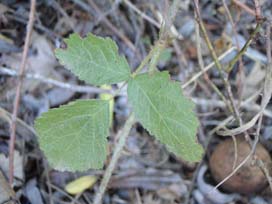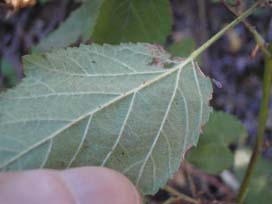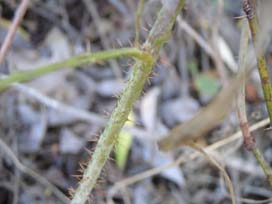


trailing blackberry
Rubus ursinus
Family: Rosaceae.
Type: Semi-deciduous ground cover.
Branching: Alternate.
Leaves: Palmately compound, usually with three leaflets. Semi-deciduous means that some leaves are always on the cane, but individual leaves do not live more than one year. Prickles are found on the underside and margins of leaves. The upper surface is occasionally somewhat hirsute.
Twig: Grows with arching canes: stems that come up, arch, and come back down to the ground again. Stems are rounded, green or whitish or occasionally slightly pink. Stems are covered with many tiny prickles, modified hairs that have become a defensive structure. Prickles have no vascular tissue; they are just an extension of the epidermal layer, and are easily detached from the stem. Roots are perennial, but canes are usually biennial: they are vegetative for their first year, producing only leaves, and then flower, fruit, and die in their second year. The vegetative phase can extend to more than one year in some cases, but once a cane flowers, that cane will die that year.
Fruit & Flower: Fruit is the blackberry, a drupe. Trailing blackberry can be dioecious (separate male and female plants), or flowers can be perfect (male and female parts in a single flower); this is variable. It is never monoecious, however (separate male and female flowers on the same plant).
Miscellaneous: Trailing blackberry is fairly shade-tolerant, and comes in as understory in forests and riparian woodlands. It is native to California. It can spread asexually by taking root wherever a cane touches the ground; this type of stem is sometimes called a stolon, as in strawberries, and blackberry spreads in the same manner.
 |
 |
 |